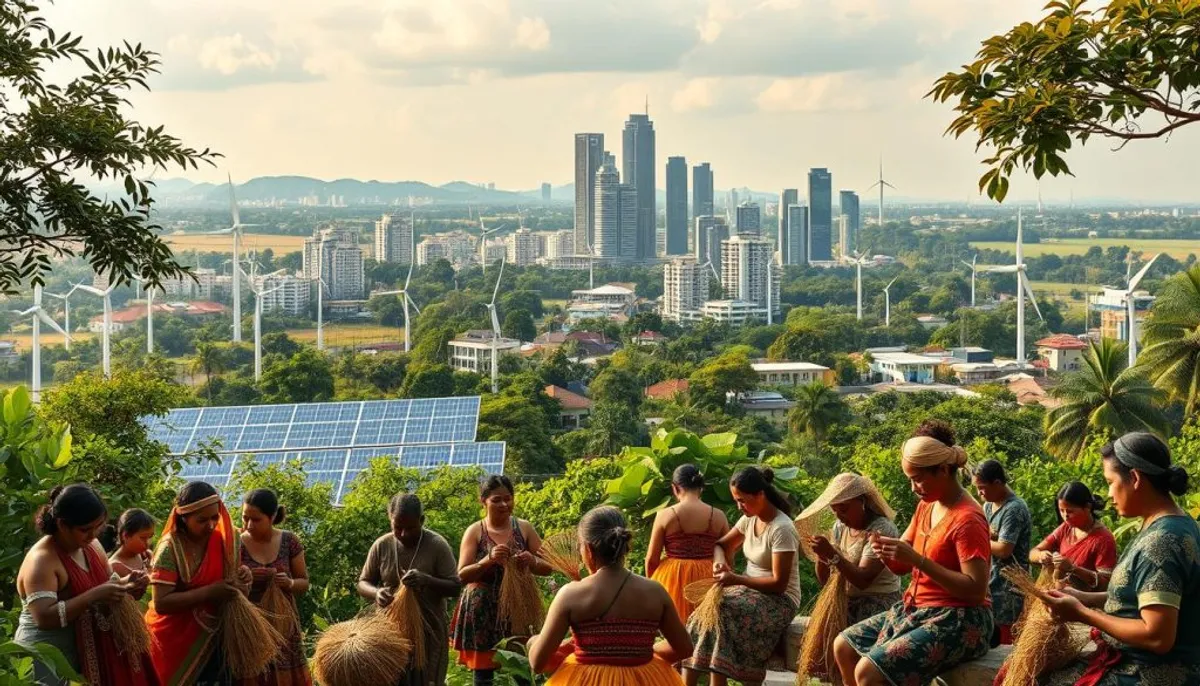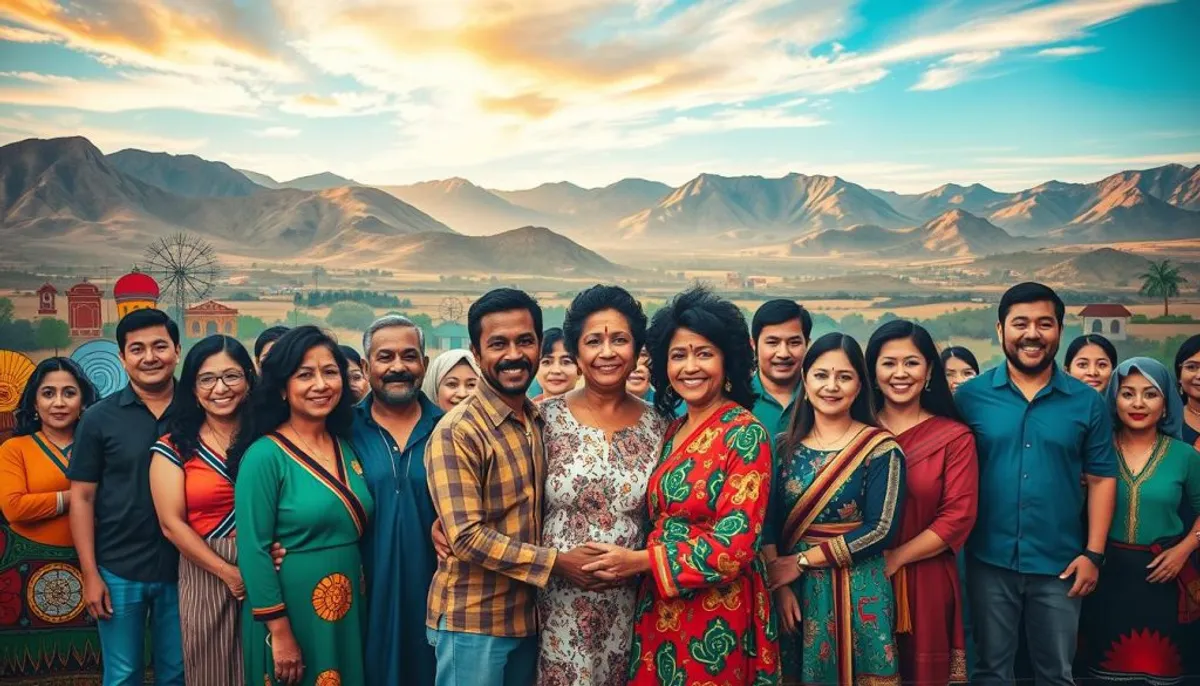Culture transcends mere entertainment. It is essential for local and sustainable development. The question of what is the relationship between culture and development is fundamental. It allows us to grasp contemporary socio-economic mechanisms.
In May 2007, the European Commission highlighted the value of Europe's cultural wealth. It emphasized its importance in a world where knowledge is paramount. This recognition underscores the role of culture as a lever for growth.

Cultural sectors are job creators and economic activities within the European Union. They enrich the cultural identity of communities. They also contribute to a more inclusive society.
Throsby demonstrated that cultural goods and services provide both monetary and non-monetary benefits. They play a crucial role in economic growth and environmental sustainability. These two aspects are pillars of sustainable development.
Culture thus exceeds the framework of our daily lives. It is a major asset for the economic and social development of our territories.
What is the relationship between culture and development
Culture is fundamental to development, influencing multiple facets of our society. Cultural heritage and cultural diversity play a key role in social cohesion and sustainable development.
The fundamental dimensions of the culture-development relationship
Culture shapes social development from childhood. It influences social behaviors and interactions with peers. Studies reveal that prosocial behaviors, such as helping others, increase during childhood. This fosters social acceptance in various cultures.
The economic and social impact of culture
Creative industries play a driving role in the economy. Culture significantly contributes to employment, representing 3 to 7% of jobs depending on the regions. It also stimulates tourism and innovation in various sectors. Cultural soft power enhances intercultural dialogue and mutual understanding between nations.
Culture as a driver of local growth
At the local level, culture stimulates economic and social development. Local cultural policies encourage cultural tourism and the creation of cultural districts. These initiatives enhance the attractiveness of territories and promote social cohesion.
| Aspect | Impact of culture |
|---|---|
| Economy | 3-7% of jobs |
| Social development | Promotes prosocial behaviors |
| Local growth | Stimulates tourism and territorial attractiveness |
The strategic role of culture in territorial development
Culture is essential in territorial development. It influences spatial organization, attractiveness, and the creation of creative districts. Its impact on local employment is significant, ranging from 3% to 7%, demonstrating its crucial economic role.
The spatial and cultural organization of the territory
Cultural identity is fundamental for land development. Cultural heritage guides urban planning, promoting sustainable development. In El Carmen de Viboral, a city of 60,000 inhabitants, the 2005-2015 cultural development plan laid the foundations for a territory organization centered on culture.
Culture as a factor of territorial attractiveness
Creative industries attract talent and investment. Cultural soft power enhances the international visibility of territories. El Carmen de Viboral has increased its cultural budget, promoting national and international events. These initiatives stimulate education, cultural tourism, and local commerce.

Cultural and creative districts
Cultural and creative districts are emerging as economic development poles. They promote social cohesion and sustainable development. The municipal cultural plan 2016-2026 of El Carmen de Viboral aims to create participation mechanisms for local actors. It encourages associative processes and community use of culture.
Culture, a cross-cutting factor in social, economic, environmental, and political development, requires adapted cultural policies. A monitoring and evaluation system is essential to measure its impact. It guides the necessary long-term adjustments.
Cultural and creative industries as levers for development
Creative industries are essential for economic and cultural development. Île-de-France illustrates this importance with impressive data. It shows how these sectors can transform a region.
The creative economy and its spin-offs
The cultural sector in Île-de-France significantly contributes to the regional GDP, reaching 21.5 billion euros. It creates 10% of jobs, surpassing traditional sectors such as automotive or aerospace. From 2019 to 2020, the creation of cultural enterprises saw a 31.2% increase, well above the national average of 27.4%.
Cultural innovation and local development
Cultural innovation is a driver of local development. The Paris region hosts over 700 creative infrastructures and training venues. It also has 8,000 cultural dissemination venues. In 2022, 500 festivals and 300 exhibitions were organized, reinforcing the cultural identity and soft power of the territory.
New cultural economic models
New cultural economic models promote sustainable development. Cultural tourism is one example: in 2019, 55 million tourists visited Paris, generating 22 billion euros in indirect economic returns. 65% of them visited at least one monument or museum, thereby valuing cultural heritage.
| Indicator | Value |
|---|---|
| Weight of the cultural sector in GDP (Île-de-France) | 21.5 billion euros |
| Jobs in culture and creative industries (Île-de-France) | 10% |
| Increase in cultural enterprise creations (2019-2020) | 31.2% |
| Economic returns from tourism (2019) | 22 billion euros |
The social and identity dimension of culture
Culture is fundamental in shaping cultural identity and social cohesion. It alters our perception of the world and shapes our interactions. Cultural practices reinforce the sense of belonging and promote social integration, essential for the sustainable development of communities.

Cultural identity is built through language, traditions, and shared values. These elements profoundly influence our behavior and perception of ourselves. For example, individuals raised in indigenous communities practicing "Potlatch" develop a worldview different from that of Western societies.
Social cohesion improves through local cultural initiatives. Between 1978 and 1984, cultural expenditures by local and territorial authorities tripled, demonstrating the importance placed on this area. These investments promote intercultural dialogue and contribute to resolving social conflicts.
| Components of cultural belonging | Impact on the individual and society |
|---|---|
| Language community | Facilitates communication and strengthens social ties |
| Common traditions | Influences behavior and creates a sense of unity |
| Shared values | Shapes individual and collective moral experiences |
| Social recognition | Promotes integration and the sense of belonging |
Local development policies encourage populations to respond to destabilizing pressures, thereby strengthening community resilience. These cultural initiatives, especially in urban areas, contribute to the revitalization of neighborhoods and engage youth, although precise quantitative data on their impact remains to be established.
Cultural heritage as a resource for sustainable development
Cultural heritage is fundamental for sustainable development. Since 1987, the Brundtland report has highlighted its importance. It is now recognized as the fourth pillar, alongside the environment, economy, and society.
The preservation and enhancement of heritage
The preservation of cultural heritage is crucial for sustainable development. Cultural policies must adopt conservation and enhancement strategies. UNESCO states that sustainable development without culture is inconceivable. Despite this, public support for cultural development remains marginal, at only 0.23%.
Responsible cultural tourism
Responsible cultural tourism represents an opportunity for sustainable development. It allows for the preservation of the cultural identity of local communities. This type of tourism promotes intercultural dialogue and supports the local economy. Initiatives like those of MIJE and FReDD promote sustainable practices through art and education.
Cultural heritage as a vector of innovation
Cultural heritage stimulates innovation in creative industries. It inspires the creation of new products and services, increasing the soft power of territories. European regional development funds support innovative heritage projects, fostering local development.
| Aspect | Impact on sustainable development |
|---|---|
| Preservation of heritage | Conservation of cultural identity, tourist attraction |
| Responsible cultural tourism | Local economic growth, intercultural exchanges |
| Cultural innovation | Job creation, strengthening territorial soft power |
Cultural policies in service of territorial development
Cultural policies are essential for territorial development in France. They encourage social cohesion and stimulate creative industries. Thus, they promote the sustainable development of regions, particularly through the enhancement of heritage. Their impact is seen through various national and local initiatives.
Local cultural governance
Local cultural governance relies on partnerships between the state and local authorities. For example, a convention was signed for 2024-2027 between the state, the Grand Est Region, the Moselle Department, and the Community of Communes of the Pays de Bitche. This collaboration aims to strengthen the local cultural fabric and promote sustainable development.
The Ministry of Culture, with its 2,400 agents in decentralized services, actively supports these initiatives. The culture and rurality plan, in particular, seeks to consolidate the place of culture in rural areas, thereby contributing to territorial balance.
Public-private partnerships in the cultural sector
Public-private partnerships are essential to energize the cultural sector. The Cultural Summer, a national initiative, supported 2,300 projects across France, illustrating the effectiveness of these collaborations. These partnerships stimulate creative industries and strengthen the soft power of territories.
Artistic and cultural education (EAC) is another major focus, with 157 territories labeled 100% EAC. This approach promotes access to culture for all, thereby strengthening social cohesion and enhancing legal learning.
| Initiative | Impact |
|---|---|
| Cultural Summer | 2,300 projects supported |
| 100% EAC Territories | 157 labeled territories |
| "Remarkable Garden" Label | 20 years of existence (since 2004) |
These cultural policies, relying on innovative partnerships and local initiatives, significantly contribute to the sustainable development of French territories.
Cultural diversity and intercultural dialogue
Cultural diversity is a valuable asset for sustainable development. It fosters creativity, innovation, and social cohesion. Statistics reveal that 89% of current conflicts occur in countries where intercultural dialogue is weak. This finding underscores the crucial importance of promoting constructive exchanges between cultures.
Intercultural dialogue plays a key role in preventing tensions. It allows for building bridges between communities and fostering mutual understanding. In 2002, the UN established the World Day for Cultural Diversity for Dialogue and Development, celebrated every May 21. This initiative aims to raise public awareness of the importance of cultural diversity.
The cultural and creative sector significantly contributes to the global economy. It represents 3.1% of the global GDP and employs over 48 million people. Interestingly, nearly half of these jobs are held by women. These figures demonstrate the economic potential of cultural diversity.
| Indicator | Value |
|---|---|
| Share of the cultural sector in global GDP | 3.1% |
| Jobs in the cultural and creative sector | 48 million |
| Share of women in cultural jobs | Nearly 50% |
To strengthen social cohesion, it is essential to promote respect for cultural differences. This involves education, media, arts, and local governance. UNESCO provides a framework for action to improve communication in our increasingly mixed societies. By cultivating open-mindedness and a willingness to engage in dialogue, we can build a more harmonious and inclusive future.
Conclusion
The study of the relationship between culture and development highlights a deep and inseparable connection. For 40 years, this relationship has strengthened, showing the importance of culture in the economy. In France, culture contributes over 2% of GDP, underscoring its essential role in sustainable development.
The adoption of the 2030 Agenda by 193 UN member states in 2015 was a key moment. The 17 Sustainable Development Goals, which now include culture as a factor of progress, marked a turning point. This international recognition underscores the importance of cultural identity in global development strategies.
Local initiatives, such as the Cultural Cooperation Charter of Lyon, demonstrate the cultural sector's commitment to sustainable development. However, challenges remain. The "colossal delay" of the cultural sector in facing environmental issues, as highlighted by Alice Audouin, requires immediate action. Culture, a source of innovation and social cohesion, must continue to adapt to remain a pillar of sustainable development and cultural identity in a constantly evolving world.
RelatedRelated articles


